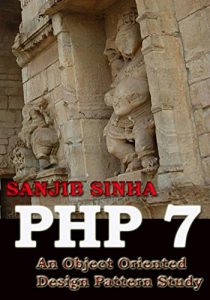PHP 7 - is kind of a revolution in the way that delivers enormous power to everything from websites and mobile to enterprises and the cloud. This is the most important change for PHP since the release of PHP 5 in 2004. It has brought explosive performance improvements, drastically reduced memory consumption, and a host of brand-new language features to make your applications soar. This book makes you ready to take that revolution under your wing by explaining the design patterns in an object oriented way.
Contents
What makes PHP 7 so special?
Who should read this book?
How to upgrade to PHP 7
Chapter 1. OOP and PHP 7
Chapter 2. A Quick Recapitulation
2.1 - Type Summery
2.2 - To Remember
2.3 - PHP Function
2.4 - More about Functions …
2.5 – Simple Classes
2.6 – Static or Dynamic?
2.7 – Constants and Variables
Chapter 3. Namespace, TRAIT and JSON
3.1 – What is Namespace?
3.2 – How to autoload Namespace?
3.3 – What is Trait?
3.4 - What is JSON?
Chapter 4. Composer Revolution
Chapter 5. SOLID Design Principle
5.1 – Single Responsibility Principle
5.2 – Open Closed Principle
5.3 - Liskov Substitution Principle
5.4 - Interface Segregation Principle
5.5 - Dependency Inversion Principle
5.6 - Interface and Method Injection
Chapter 6. Overview of Classes and Objects
Chapter 7. Get, Set and Go…
Chapter 8. Hiding Information
Chapter 9. Inheritance, Encapsulation, Abstract Classes, Interfaces
9.1 - Introducing Abstraction and Encapsulation
9.2 - Defining Abstraction
9.3 - Defining encapsulation
9.4 - Difference between Abstraction and Encapsulation
9.5 - Abstract Classes
9.6 - Basic Interfaces
Chapter 10. What is Design Pattern?
Chapter 11. What is Your Strategy?
Chapter 12. More about Architecture
12.1 – Compose the Architecture
Chapter 13. Factory Patterns
Chapter 14. Decorating Applications
Chapter 16. Responsibility Unchained
Chapter 17. Adapt SMS into MAIL
Chapter 18. The Template Pattern
Chapter 19. Relationships between Classes
Chapter 20. Static Variables, Static Functions and Singleton Pattern
Chapter 21. More on PHP 7
Contents
What makes PHP 7 so special?
Who should read this book?
How to upgrade to PHP 7
Chapter 1. OOP and PHP 7
Chapter 2. A Quick Recapitulation
2.1 - Type Summery
2.2 - To Remember
2.3 - PHP Function
2.4 - More about Functions …
2.5 – Simple Classes
2.6 – Static or Dynamic?
2.7 – Constants and Variables
Chapter 3. Namespace, TRAIT and JSON
3.1 – What is Namespace?
3.2 – How to autoload Namespace?
3.3 – What is Trait?
3.4 - What is JSON?
Chapter 4. Composer Revolution
Chapter 5. SOLID Design Principle
5.1 – Single Responsibility Principle
5.2 – Open Closed Principle
5.3 - Liskov Substitution Principle
5.4 - Interface Segregation Principle
5.5 - Dependency Inversion Principle
5.6 - Interface and Method Injection
Chapter 6. Overview of Classes and Objects
Chapter 7. Get, Set and Go…
Chapter 8. Hiding Information
Chapter 9. Inheritance, Encapsulation, Abstract Classes, Interfaces
9.1 - Introducing Abstraction and Encapsulation
9.2 - Defining Abstraction
9.3 - Defining encapsulation
9.4 - Difference between Abstraction and Encapsulation
9.5 - Abstract Classes
9.6 - Basic Interfaces
Chapter 10. What is Design Pattern?
Chapter 11. What is Your Strategy?
Chapter 12. More about Architecture
12.1 – Compose the Architecture
Chapter 13. Factory Patterns
Chapter 14. Decorating Applications
Chapter 16. Responsibility Unchained
Chapter 17. Adapt SMS into MAIL
Chapter 18. The Template Pattern
Chapter 19. Relationships between Classes
Chapter 20. Static Variables, Static Functions and Singleton Pattern
Chapter 21. More on PHP 7












